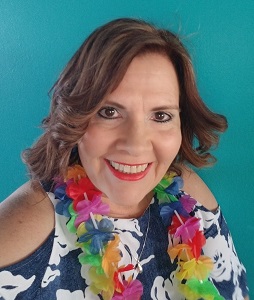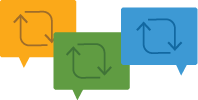July 2019 Featured Educator: Sandra García de la Noceda

Tell us a little about your teaching experience and your current position.
I started teaching in Puerto Rico in 1988. My first year was in the primary grades, teaching all subjects which I loved but I ended up teaching Math, from Fourth to Sixth Grade. Throughout my career, I taught all grade levels. In 2010, I moved to Palm Beach. Going to interviews was very stressful, but after my third one, I was hired at Cholee Lake Elementary, where I taught Second Grade until 2017, when I became the Dual Language Coach. As part of my responsibilities, I work with groups of students at similar levels of development teaching them reading strategies they can apply to all books. I use texts that are carefully matched to each group’s unique needs. English is not my first language so I feel I’m still an ELL as well.
Describe your class, school and district and tell us what language services look like in your school.
The School District of Palm Beach County is an A-rated district and has the highest number of district-operated “A” schools when compared with other large urban school districts. Cholee Lake Elementary has an enrollment of 1,073 students; 14% are black, 75% Hispanics, 7% white and 4% others. Among those, 63% are ELL. We are located in Greenacres, Florida, and the majority of our students come from, “Casa del Monte,” a mobile home complex with low income families. Of our population, 92.26% have free or reduced lunch. We are a “C” school, working hard to be “B” or “A.”
We are a Choice School with the Dual Language Program from Kindergarten to Fifth Grade. Four hundred eleven students benefit from this program. Our program allows native English speakers to acquire the Spanish language and native Spanish speakers to acquire the English language. Our students learn 50% of the day in each language.
The goal of our program is to create an environment that promotes equity and positive cross-cultural attitudes while students become bilingual and bi-literate; thus laying the groundwork for future success in the international marketplace.
The ELL students that are not in the Dual Language Program benefit from the ESOL Program. This program assists students in reaching their highest academic potential by supporting their social, emotional, academic and linguistic development in the educational setting. We have two guidance counselors who foster academic achievement, college and career readiness, and social/emotional development for all students through direct counseling services and collaboration with teachers, administrators, parents and community.
Why did you choose to become an educator? What do you love about your job? What frustrates you?
Since I was a kid, I dreamed about being a teacher and pictured myself seated on a carpet, reading to kids around me. I married a teacher who shared with me his amazing experiences and helped me make the final decision. I love my students! Many of them come from different countries with sad stories about their lives in their countries. They need, not just instruction, but love and patience. I get frustrated when parents don’t help and support their kids and when students are “labeled” with a learning disability when it’s really a language issue.
What is your approach towards supporting language learning in your classroom and school? What techniques/strategies have you found to be most effective in teaching language learners? Are certain WIDA tools helpful?
In order for students to be willing to learn another language, they must understand the importance and the benefits of learning another language. Learning another language doesn’t mean that you have to lose your identity and your cultural background but rather for opening a world of opportunities.
I love the “Can Do Booklets” with the Performance Definitions and Can Do Descriptors. They provide teachers with information on the language students are able to understand and produce in the classroom and apply to all five English Language Proficiency Standards. For our Spanish Dual Language component, the Spanish Language Development Standards document has been very helpful.
How do you encourage students to learn? How do you accelerate their language development and ensure their equitable access to content learning?
Students must understand that learning another language is going to be rewarding and beneficial. I always show excitement when teaching and highlight how they are enriching their vocabulary and opening more opportunities to communicate with other people. Students must be able to make connections between what they are learning and the real world.
How do you determine which language standard(s) to focus on in a lesson? Describe your planning process to address the needs of your students. How do you manage to collaborate with content area teachers?
Our school creates a Focus Calendar based on the district’s Scope and Sequence Calendar. Each team meets during our Professional Learning Community or common planning schedule to create the lesson plans for the whole team. It is important to set up a learning goal, which includes the skills and knowledge the students need to learn as a result of the lesson. During guided reading, the teachers give individualized instruction based on the students’ reading levels and needs. All subject teachers, ESOL teachers and coaches work together to create meaningful lesson plans that can meet the needs of our students. WIDA, ESOL and ESE strategies are incorporated, among others.
What benefits of strength do language learners bring to your classroom and school? What benefits do their families bring to schools or the surrounding community?
Students who come from other countries bring new experiences and vocabulary that all of our students can benefit from. While learning another language, they can preserve important relationships, traditions and identity. Students learn how to embrace diversity and validate each other. Getting English skills provides the ability to participate fully in the American life. Living in a multicultural society gives you the opportunity to learn things about other people you otherwise would need to travel abroad for.
What methods or tools do you use to assess your students' language learning?
We use different kinds of formal and informal assessments to evaluate the students’ language learning. Students are assessed not just by tests but by portfolios, short comprehension checks, oral presentation, projects, reflection logs, reading response logs, written assignment and reading activities, among others. Rubrics and performance criteria are great ways to access a variety of students’ work. Pictures and role play are very useful, especially with shy students who are afraid to talk.
How has WIDA helped you achieve your goals as an educator?
Thanks to WIDA resources and strategies I can be more organized. They help me measure the growth of individual and whole-group learning. Using the Performance Definitions and Can Do Descriptors helps me adjust the learning and support accordingly. I can create more meaningful lesson plans based on the student’s uniqueness and needs.





